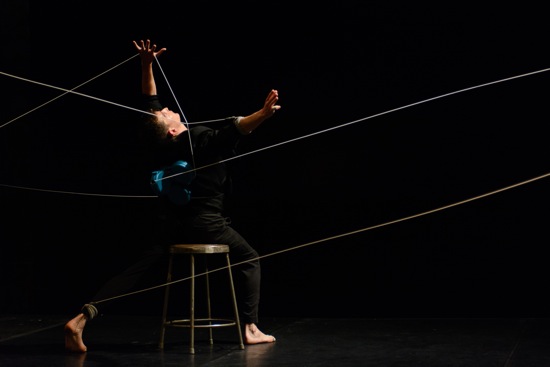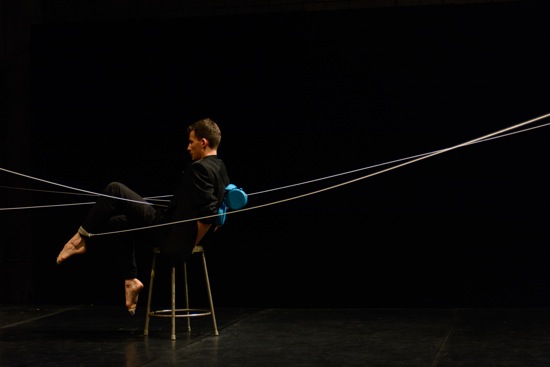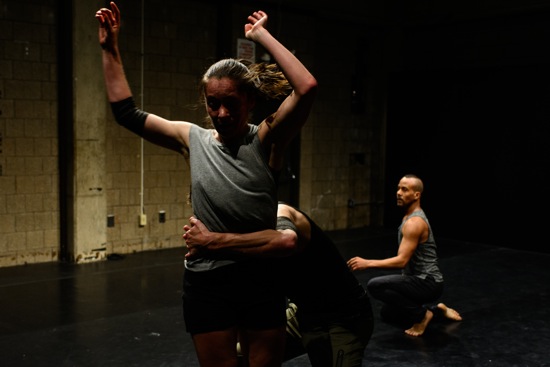Kimberly Bartosik and Dylan Crossman share a program in a confined space.
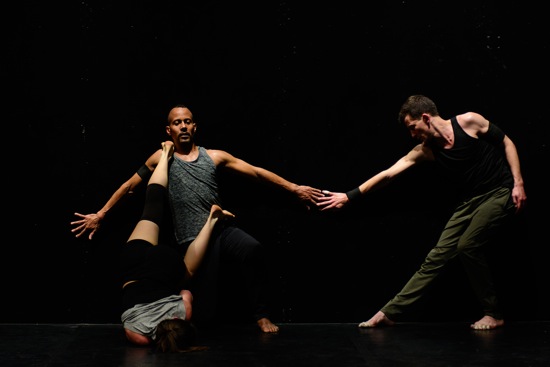
Melissa Toogood (on floor), Marc Mann (L), and Dylan Crossman in Kimberly Bartosik’s Ecsteriority 4 (Part 2). Photo: Ryutaro Mishima
Kimberly Bartosik, Dylan Crossman, and Melissa Toogood all danced in Merce Cunningham’s company—Bartosik for nine years a few decades ago, Crossman and Toogood in the company that was finally disbanded in 2011. What perhaps should not surprise us is the emotional resonance and implications of drama that imbue the works that Bartosik and Crossman premiered on their shared program at Abrons Art Center (part of a series, Travelogues, curated by Laurie Uprichard), and which affect all the works by Bartosik that I’ve seen. After the three had lived through so many years of being warned that (despite some evidence) no stories were being told in a Cunningham dance and that the movement was the meaning, any urges toward narrative must have huddled in each one’s subconscious like a ticking time bomb.
Yet one part of their heritage is ineradicable. Crossman and Toogood, who have recently been performing for an amazing number of choreographers, drive their minds and bodies into fully engaging with each moment, without “performing” and without embellishment—giving neither too much nor too little. I used to think that when a really fine Cunningham dancer raised an arm, his or her entire being was in that arm. Cunningham was not among the many choreographers that Marc Mann has worked with, but he also has that intentness of focus, a quality crucial to Bartosik’s new Ecsteriority 4, Part 2, a trio for Crossman, Toogood, and him.
Bartosik has always made the performance space an active contributor to her choreography. The Experimental Theater at Abrons is not what I’d call a friendly space. It’s a long, narrow, tomblike room with a high ceiling, a black marley floor, and walls made of rough-surfaced beige tiles. It perfectly suits Crossman’s Bound, which opened the program. While the small audience crams into chairs on risers that are set along the narrow end of the space, Crossman is already in place, seated on a long-legged metal stool. He is enmeshed in a web created by five white ropes. One is attached to a band around his right arm; another is affixed to his left ankle. Three bright blue pulleys are sewn to the back of his black jacket. The other ends of the ropes stretch to pulleys high up on the walls or to lower points (Hubert Lafore designed this element of the solo).
It’s not clear whether this prisoner (or experimenter) has a fixed goal or a problem to solve. He twists within the ropes several times in exactly the same way, but also occasionally runs a hand carefully along one, as if assessing its strength. And liking its feel. He reaches an arm high, then drops whatever idea he might have had. He pulls against the ropes’ tension. He dances imaginatively within the snare (almost too wonderfully, I thought, a couple of times when his moves seemed less deeply rooted in his purposes).
Maybe the solo is symbolic of a dancer’s work. He is bound by traditions and the techniques he has acquired. How to use them, own them, discard them? A dull roar predominates in Jesse Stiles’s sound design. Carrie Woods’ lighting—harsh white at first, warmer later—employs one extremely eerie effect. Those of us seated in the front row (and maybe also further back) suddenly discover that the programs in our laps are fluorescing. Imagine the puzzlement. (I discover—whew!—a couple of ultra violet light above us and wonder if my bones could start melting. Every single one of Crossman’s toes is bandaged; they’ll light up too, if he ventures close enough).
As you might imagine, Crossman—a marvelous dancer— draws us into his small, taut world. He slips the rope off his arm, removes his jacket; now only one leg is bound. Then he frees that. Then he re-attaches the rope to his arm. Thinks. Removes it again. Silence. But he’s not wholly free; he dances energetically, with his hands behind his back, then sits on the floor and looks at us. He feels his way into an avenue between two attached ropes and thrashes along it. What is he up to?
When he detaches an end of one rope, a pulley sucks it up. And then a second is released. Is he through? He begins to repeat a short phrase of dancing over and over, bending, jumping, turning. The lights begin to dim slowly, slowly. He’s still going over the phrase when darkness falls.
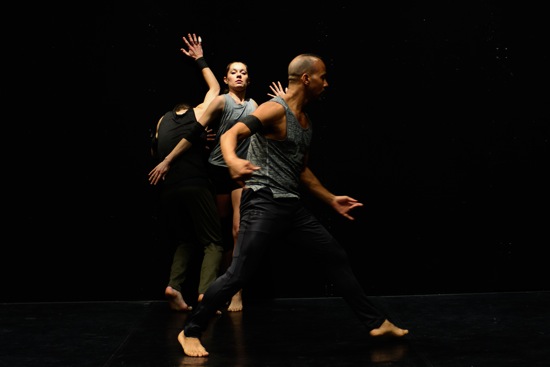
(L to R): Dylan Crossman, Melissa Toogood, and Marc Mann in Kimberly Bartosik’s Ecsteriority 4 (Part 2). Photo: Ryutaro Mishima
A pause separates Bound from Bartosik’s Ecsteriority 4, Part 2. After a few minutes, Toogood enters through one of the room’s two doors and climbs up the aisle to the top, still arranging a wide piece of black elastic fabric around her wrist; when Mann enters, she fixes his wrapping—like a trainer readying a prizefighter. (Bartosik likes it that most of us have to turn around to see this.) Then the main door opens as if by magic, and Crossman—dried off and cleaned up—enters. The door closes, as if of its own accord, and the piece begins with the furor of a Pandora’s box being opened.
The three dancers walk, then race toward the wood-paneled end wall and slam into it. Bang! End-of-the-world aural effects erupt from the speakers (sound design by Bartosik, with excerpts from Animals Collective, Untitled). You hear what could be voices shrieking amid the roar. As if the wall were a powerful magnet, an adversary, the dancers twist erratically, slapping it with a hand, kicking it with a foot, but always pressed against it in some way. Until they break loose. Mann runs in circles. Crossman joins him, more or less shoulder to shoulder, then returns to the wall. Toogood runs to Mann. One image sticks in my memory: Toogood, on tiptoe, presses her back against one of the side walls; slightly instable, intent on the space and the men, she’s also consulting herself.
Aspects of the uneasy tensions and encounters hark back to Bartosik’s 2008 Ecsteriority 1 & 2. In that, Mann and Elke Rindfleisch also related to a wall and tangled their limbs together in ways that foreshadowed Ecsteriority 4. I think suddenly of Jean-Paul Sartre’s existential play, No Exit, in which three strangers, after their deaths, are locked in a room together for eternity; that is their punishment. In the end, the door opens, but no one leaves. I also ponder Bartosik’s title, with its mash-up of “ecstasy” and “exteriority.” Even in moments of passion, we often observe ourselves as if from a distance.
It makes sense that Crossman, Toogood, and Mann are dressed for action in mostly gray and black, and that they have additions like the arm wrappings and other protective items (attire designed by Bartosik, with input from Reid Barthelme and Jennifer Goggans). This is a ferocious piece. At one point, Mann all but throws Crossman to Toogood. And their arms and legs become both instruments and traps.
But, however they struggle together, their impulses are not mindless; they watch one another intently, as if they need to be vigilant (or forewarned). At various times, one or more of them reclines, supporting his/her upper body on forearms, and stares at the goings on. Toward the end, Toogood and Mann face each other, standing so close together that their faces are almost touching (if this were a movie, they’d kiss).
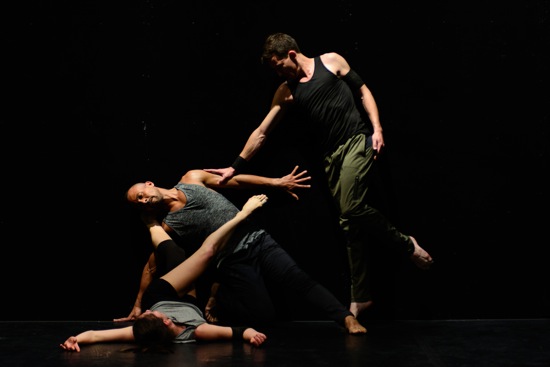
(L to R): Melissa Toogood, Marc Mann, and Dylan Crossman in Kimberly Bartosik’s
Ecsteriority 4 (Part 2). Photo: Ryutaro Mishima
Here’s a sampling of their endeavors. Toogood and Mann, lying close together on the floor, back away from Crossman, rotating as they go; yet they keep their eyes on him as much of the time as they can. He looks as if he would like to reach them, but can’t. After this, Mann struggles along the floor, with Toogood’s legs impeding his progress. Another time, Mann pushes Crossman up the wooden paneling until he can hook a hand over its top edge, but nothing comes of it, and what either of them desires is not easily decipherable. Toogood, lying on her back, traps Mann against the wall with her feet; Crossman attaches himself to them. Together and momentarily motionless, they resemble one of those heroic battle sculptures. Then Crossman steps into the web of limbs to alter the picture. At one point, he lies inert, and the others hover or drop onto him; when Mann and Toogood then tangle in complicated ways, he finds ways to intrude into their maneuvers.
The intimacy is fierce, the reactions of the dancers’ bodies’ complex, and the wall can be both a colleague and an enemy. Near the end, though, she charges at it and stops short, as if it were now emitting a negative force. We in the first row feel another kind of intimacy. The dancers often come very close to us. I could reach out and touch one. Their breathing, their charged presences change my own breathing.
Roderick Murray’s lighting alters things also, as does the music. It may stop for seconds, during which time you forget how violent the sounds are; then they shout at you again. Near the end, the three dance in unison—their feet quick in contrast to the way they often momentarily suspend their balance on one leg or swing a leg heavily. They never move with a literal intent to squabble; a calm element to their ferocity gives their dancing some of the nuances of thought.
At one point, you’re certain the end is near. Toogood, again supine, arranges the two men against the wall with her feet. Mann slides down and sits. So does Crossman, and then his arm, which seems pasted to the wall, slides down too. The lights are dimming. Bartosik is not done yet though. Her work finishes when these remarkably gifted and sensitive performers leave the room, one by one. Crossman and Toogood use the same door. Mann the other one.
If the world doesn’t fall apart before then, Ecsteriority 4 will premiere as an evening-length work at the Chocolate Factory in 2016-2017.

